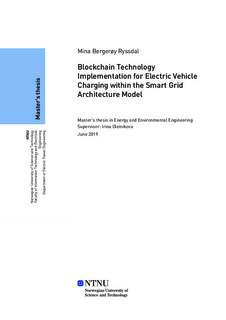| dc.contributor.advisor | Irina Oleinikova | |
| dc.contributor.author | Mina Bergerøy Ryssdal | |
| dc.date.accessioned | 2019-11-06T15:03:52Z | |
| dc.date.available | 2019-11-06T15:03:52Z | |
| dc.date.issued | 2019 | |
| dc.identifier.uri | http://hdl.handle.net/11250/2627028 | |
| dc.description.abstract | Denne oppgaven undersøker potensialet for å implementere blokkjedeteknologi som et verktøy i smarte nett.
De tradisjonelle energisystemene står for tiden overfor nye utfordringer og gjennomgår en overgang til smartere og mer komplekse energisystemer. Energi- og klimapolitikk og trender fører en utvikling av smarte nett. Smarte nett integrerer nye løsninger og tjenester, og er preget av en omfattende bruk av informasjons- og kommunikasjonsteknologi.
Smart Grid Architecture Model (SGAM) er introdusert som et rammeverk i smarte nett for å øke forståelsen av nye og kompliserte konsepter. SGAM-metoden som en standardisert tilnærming brukes her for å utvikle brukstilfellet for lading av elbiler i smarte nett. Et av fokusområdene i smarte nett er å tilrettelegge for den voksende andelen elbiler som skal kobles til kraftnettet.
Blokkjedeteknologi får oppmerksomhet i energisektoren som et lovende verktøy i det stadig mer komplekse kraftsystemet. Den nye teknologien har potensialet for å påvirke driften av kraftsystemet og kraftmarkeder ved å redusere markedsfriksjoner og redefinere roller i systemer. Ved å analysere blokkjedeteknologis egenskaper, kan det ses at teknologien kan støtte endringer i energisystemet, og bidra til IKT behovene i et mer desentralisert og dynamisk kraftsystem, hvor forbukerne er i hovedfokus.
Den desentraliserte arkitekturen i elektrisk mobilitet er et lovende applikasjonsområde for blokkjeder i smarte nett. De involverte funskjonene og interaksjonene kan avdekkes ved å vurdere prosessen ved elbillading. Her kan blokkjedeteknologi brukes som informasjonsteknologi for sikre, interoperative og innovative ladesystemer. Blokkjeder kan redusere interaksjons- og informasjonsfriksjon i en ladeprosess. Et spesifikt applikasjonsscenario for blokkjedeteknologi for elbillading er utviklet, hvor systemet forbinder aktørene og funksjonene i ladeprosessen. I tillegg kan løsningen gi forbukerne mulighet til å bidra med tjenester for driften av kraftsystemet.
Ladesystemet er implementert på en eksisterende blokkjedeplatform for å bekrefte gjennomførbarheten av applikasjonsscenarioet. | |
| dc.description.abstract | This thesis investigates the potential of implementing the novel blockchain technology as a tool in smart grids.
Traditional energy systems are currently facing new challenges and undergoing a transition towards smarter and more complex energy systems. Energy and climate policy and interrelated trends are driving the power system towards smart grids. Smart grids integrate new solutions and services and are characterised by extensive utilisation of information and communication technologies (ICT).
The Smart Grid Architecture Model (SGAM) is introduced as a framework to increase the understanding of smart grid concepts. The SGAM methodology is used as a standardised approach to developing the smart grid use case "electric vehicle charging".
One of the focal points in smart grids is to fully integrate the growing electric vehicle fleet into the power system.
Blockchain technology is gaining attention in the energy sectors, as a promising tool in the increasingly complex system. The novel technology has the potential to transform operations and markets by reducing friction and redefining roles in a system.
By analysing the blockchain technology characteristics, it is recognised the technology can support the energy transition, and contribute to the ICT needs of a decentralised and dynamic power system with consumers at heart.
The decentralised architecture of electric mobility, with multiple actors, is as a promising application area for blockchain in smart grids. By considering the use case "electric vehicle charging" developed according to the SGAM methodology, functions and interactions involved are revealed. Here blockchain technology can be applied as an information technology to provide interoperable and innovative charging systems. Blockchain can reduce interaction and information frictions in a charging process while securing information and transactions. A specific application scenario is developed, where a blockchain-based system connects the actors and processes functions in electric vehicle charging. Additionally, the solution can integrate information flow for the provision of services to the power grid operation through demand response.
The blockchain-based charging system is implemented on the Ethereum blockchain platform for proof of concept. The implementation and simulation prove a feasible solution by the use of smart contracts. | |
| dc.language | eng | |
| dc.publisher | NTNU | |
| dc.title | Blockchain Technology Implementation for Electric Vehicle Charging within the Smart Grid Architecture Model | |
| dc.type | Master thesis | |
